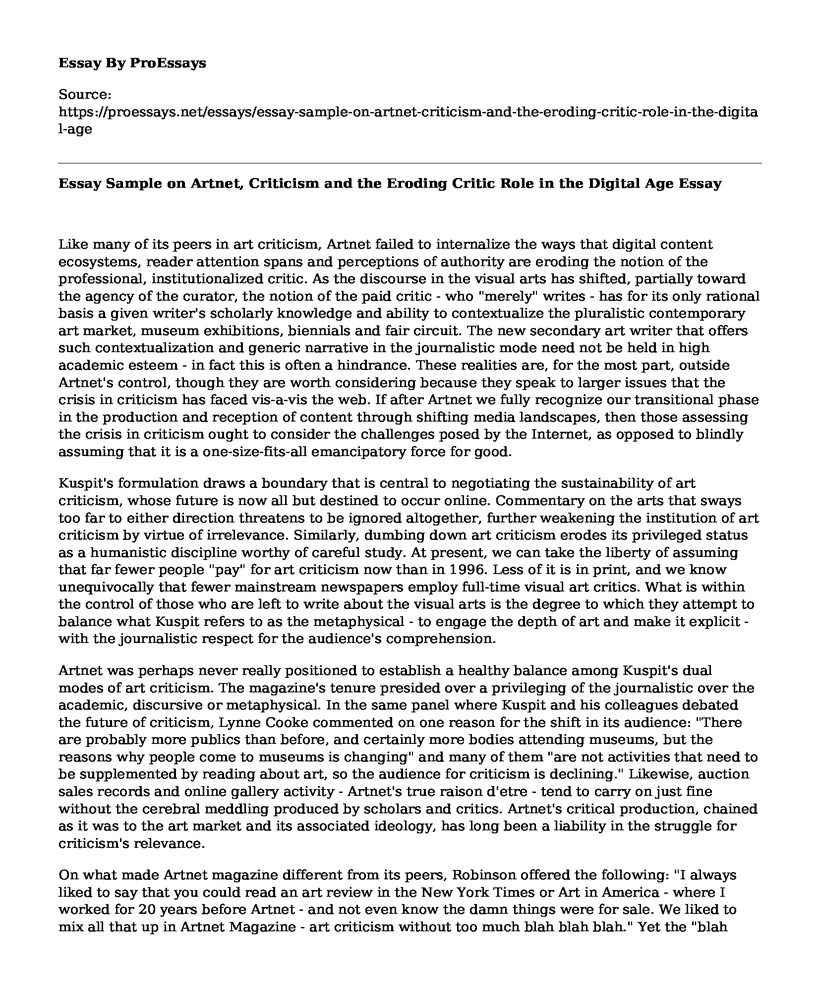Like many of its peers in art criticism, Artnet failed to internalize the ways that digital content ecosystems, reader attention spans and perceptions of authority are eroding the notion of the professional, institutionalized critic. As the discourse in the visual arts has shifted, partially toward the agency of the curator, the notion of the paid critic - who "merely" writes - has for its only rational basis a given writer's scholarly knowledge and ability to contextualize the pluralistic contemporary art market, museum exhibitions, biennials and fair circuit. The new secondary art writer that offers such contextualization and generic narrative in the journalistic mode need not be held in high academic esteem - in fact this is often a hindrance. These realities are, for the most part, outside Artnet's control, though they are worth considering because they speak to larger issues that the crisis in criticism has faced vis-a-vis the web. If after Artnet we fully recognize our transitional phase in the production and reception of content through shifting media landscapes, then those assessing the crisis in criticism ought to consider the challenges posed by the Internet, as opposed to blindly assuming that it is a one-size-fits-all emancipatory force for good.
Kuspit's formulation draws a boundary that is central to negotiating the sustainability of art criticism, whose future is now all but destined to occur online. Commentary on the arts that sways too far to either direction threatens to be ignored altogether, further weakening the institution of art criticism by virtue of irrelevance. Similarly, dumbing down art criticism erodes its privileged status as a humanistic discipline worthy of careful study. At present, we can take the liberty of assuming that far fewer people "pay" for art criticism now than in 1996. Less of it is in print, and we know unequivocally that fewer mainstream newspapers employ full-time visual art critics. What is within the control of those who are left to write about the visual arts is the degree to which they attempt to balance what Kuspit refers to as the metaphysical - to engage the depth of art and make it explicit - with the journalistic respect for the audience's comprehension.
Artnet was perhaps never really positioned to establish a healthy balance among Kuspit's dual modes of art criticism. The magazine's tenure presided over a privileging of the journalistic over the academic, discursive or metaphysical. In the same panel where Kuspit and his colleagues debated the future of criticism, Lynne Cooke commented on one reason for the shift in its audience: "There are probably more publics than before, and certainly more bodies attending museums, but the reasons why people come to museums is changing" and many of them "are not activities that need to be supplemented by reading about art, so the audience for criticism is declining." Likewise, auction sales records and online gallery activity - Artnet's true raison d'etre - tend to carry on just fine without the cerebral meddling produced by scholars and critics. Artnet's critical production, chained as it was to the art market and its associated ideology, has long been a liability in the struggle for criticism's relevance.
On what made Artnet magazine different from its peers, Robinson offered the following: "I always liked to say that you could read an art review in the New York Times or Art in America - where I worked for 20 years before Artnet - and not even know the damn things were for sale. We liked to mix all that up in Artnet Magazine - art criticism without too much blah blah blah." Yet the "blah blah blah" to which Robinson refers is critical. Such is the rarefied judgment of a critic, which, under the enlightenment model, is the very commodity justifying their existence. The art-writing industry, as frail as it has been, developed around this privileged space. Mocking the specialized nature of the discourse is akin to killing the goose that laid your hermeneutic golden egg.
Its editorial position notwithstanding, the fact that Artnet once provided a voice for either side of such a debate, and that this voice is now lost, is lamentable. Under Kuspit's rubric, Artnet arguably represented the height of journalistic criticism - and if we update the terms of the 1996 panel debate to include the collective experience of humanism in the digital age we have known since, Kuspit's polarity gains new resonance. Amidst the decline of art criticism, the practice will have to seek new models beyond those based solely on the emancipatory promises of the Internet. As the ubiquity of facile commentary spreads by way of - though not necessarily because of - blogs and a democratized publishing sphere, criticism can count among the developments threatening its extinction the waning reliance on its ever-more-distant academic cousin. The less rigorous journalistic criticism can be produced by anyone with a pithy take on a Chelsea gallery show, very well squeezing out those who respect art's metaphysical potentialities: its unique relationship to history, culture and judgment about which Kuspit speaks.
Cite this page
Essay Sample on Artnet, Criticism and the Eroding Critic Role in the Digital Age. (2023, Jan 30). Retrieved from https://proessays.net/essays/essay-sample-on-artnet-criticism-and-the-eroding-critic-role-in-the-digital-age
If you are the original author of this essay and no longer wish to have it published on the ProEssays website, please click below to request its removal:
- Risk Perception and Risk Management Paper Example
- Leadership as One of the Critical Skills - Essay Sample
- The Story Behind Each Cup of Coffee Essay Example
- Essay Example on Native American Historical Trauma: Evidence-Based Practice Prospects
- Make Paper Snow Flakes for Christmas Decorations: Process Analysis Essay
- Paper Example on Leadership Through Tribal Understanding: A TED Talk by David Logan
- Starbucks: Brand Positioning - Report Sample







